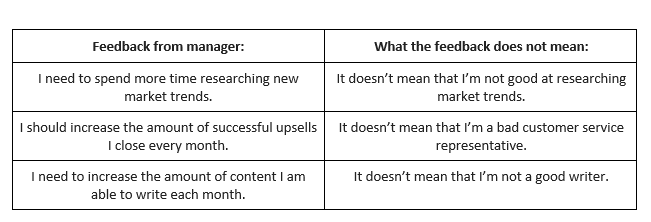How To: Give Great Feedback & Reap The Benefits

We recently talked about an Aesop fable that we’ve used to help boost revenue.
What did we learn? ”Please all and you’ll please none.”
Managers everywhere can relate. Understanding how to work with different people who need different things to grow, develop and perform… it’s not easy. And sometimes it feels like you simply cannot win.
Should you just accept the fact that part of being a manager is being criticized no matter what?
Sure… this is one option.
Luckily, there is an option “B.” It’s called engagement.
If you can generate genuine engagement amongst your team, then respect, motivation and efficiency will follow.
So basically, you will have become a modern day Don Corleone… but less scary, and maybe not as well-dressed.
The point is that by communicating openly and engaging your team, you create the opportunity for people to understand you, how you think and how you make decisions on a deeper level.
One important tip here: remember that listening is a critical part of communicating and creating engagement. You’ll never ever reach “Don” level by talking at people.
Your workplace and professional life can become free(ish) of counterproductive conflict, fueling synergy, efficiency, and quality. And ultimately, your company’s bottom line should mirror the results of your managerial effectiveness. Everyone wins.
Now you’re probably wondering… how? Where do I start?
A lot of this process will depend on your leadership style, which is generally unique to each person and requires a lot of work to change. But there are a few things you can do to boost your department’s productivity. One of the most important, without a doubt, is giving effective feedback.
Throughout your career you’ve probably had so many experts and colleagues telling you about the importance of feedback. But those are just words and opinions….. we like real data.
For example:
- Deloitte found that when organizations embrace a culture of coaching, they experience an average of 21% boost in business results.
- The Boston University Questrom School of Management concluded, more conservatively, that effective feedback results in 11% increase in productivity.
- The Harvard Business Review found a direct correlation between employees who rank low on engagement and performance and those who ranked their leaders lowest at providing feedback.
While 99.9% of leaders agree that a culture of feedback is important for business success (or so they say); they get stuck not knowing how to do it.
See, we tend to focus on the content (verbal communication), underestimating what really drives the interaction. Specifically, behavioral science tells us that content is actually the least important aspect of effective feedback.
Which sounds completely absurd…
… unless you understand mirror neurons.
Because of mirror neurons, we tend to vicariously experience other people’s emotion. Studies using MRI’s show that when people are exposed to recordings of others experiencing positive or negative emotions, that their brains mirrored such feelings. So, if the person giving you feedback is having a bad day and is dreading delivering negative feedback to you….. you’ll come out of that conversation bitter and feeling attacked.
No one wants that…
So we’re going to help you collect the kind of feedback that leads to positive change and not divisiveness and defensiveness. Ready? Here goes…
Our Top 5 Tips for Delivering Effective Feedback
1.) Check your inner dialogue. Everyone (yes that includes you and me) is subject to a horrible monster called the “fundamental attribution error.” This leads us to underestimate situational factors. We forget that others’ actions are driven by their innate disposition (ex: Joanne didn’t get the report done because she just doesn’t understand its importance). Take a step back and focus on your mood and biases before giving feedback. If necessary, postpone your feedback session to a better time.
2.) Check your nonverbal cues. If there is an incongruence between what the person providing feedback thinks of the situation and what they actually say, the receiver will most likely discount the content and believe the nonverbal cues. Look out for micro expression (both yours and the receiver’s)
3.) Forget the feedback sandwich, keep it positive. I am sure by now, you’ve met someone that told you that you should always deliver feedback following the order positive → negative → positive. Well, how has that worked for you so far? Chances are …not great. Actual empirical research suggests that the ratio of positive feedback to negative one should be much higher. 6:1 to be exact.
4.) Explain Explain Explain! When you get to the negative feedback part of your session, take your time. Explain why the feedback is needed, how it impacts your work and how it makes you feel. Go into the whys and encourage questions and challenges to your feedback.
5.) Use a feedback chart. If you still encounter resistance, a feedback chart can be helpful. Keep it simple and relevant like the one below.









